Nov 22, 2024
What is Amazon SES and Why Consider Alternatives
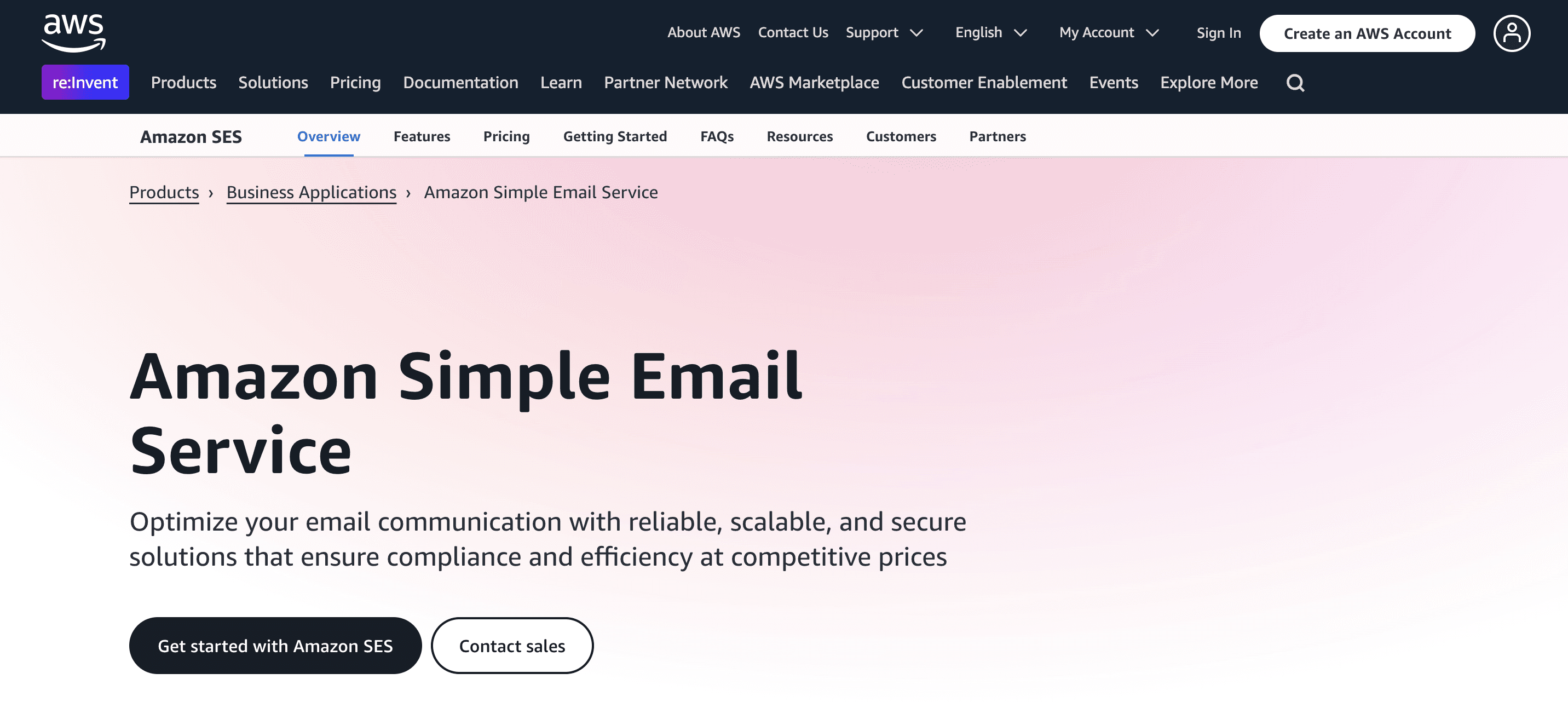
Amazon Simple Email Service (SES) is an email-sending service that can be seamlessly integrated into your applications to send marketing, bulk, and transactional emails. As an AWS product, it offers cloud-based email solutions that help you communicate better with your customers. Using Amazon SES, you can send emails to your customers and receive replies to those emails. With its affordable price and robust features, Amazon SES is a popular choice among online businesses looking to boost their email deliverability.
Why Use Amazon SES?
Amazon SES is a solid choice if you’re looking for an email service to send transactional emails. It boasts high deliverability rates, meaning your emails are more likely to land in your customers’ inboxes than in the spam folder. This is especially important for transactional emails, as these communications must reach your customers promptly. Amazon SES helps ensure your emails get delivered on time. It also offers easy integration with the rest of Amazon’s infrastructure, making it an appealing option for existing Amazon users.
The Pros and Cons of Amazon SES
While Amazon SES has merits, exploring alternatives can provide unique features, enhanced usability, and specialized functionalities. The pros and cons of Amazon SES are as follows:
Pros
The following are some of the main benefits of using Amazon SES:
ISP Standard Compliance
Amazon SES filters content to meet ISP standards, ensuring deliverability and flagging content for correction.
Reputation Dashboard
Track bounce rates and feedback loops with Amazon SES's reputation dashboard, taking proactive steps to maintain sender reputation.
Dedicated IPs
A managed dedicated IP address with Amazon SES automatically sets up and manages dedicated IP addresses on your behalf, providing an easy and fast way to start using them.
Control Over Email Acceptance
Have full control to accept or reject emails based on the sender's email address, IP address, or domain.
Unsurprisingly, nearly 157,000 businesses have embraced Amazon SES as their preferred email service provider.
Cons
Yet, Amazon SES has its own set of drawbacks that should be noted as well:
Initial complexity
Setting up Amazon SES may require assistance from developers, as its initial process is more complicated than that of other ready-to-use email services.
Limited features
The lack of core features such as list management makes Amazon SES difficult to set up for non-web developers.
Absence of A/B testing
Unlike many other email marketing services, Amazon SES does not offer A/B testing, which could be a limitation for businesses that rely on this feature.
Desktop-Only Availability
Amazon SES is available only through desktops, lacking a dedicated mobile app version.
Integration Constraints with Third-Party Platforms
Every product has its limitations, and despite its strengths in terms of transactional emails, there are circumstances where AWS SES may need to align better with your company's needs. Other email providers might be a better choice if any of these cases are a deal breaker.
When to Consider Alternatives to Amazon SES
While Amazon SES serves various industries and fields, there are situations where alternative solutions may be more suitable:
Advanced Email Marketing
Businesses requiring advanced email marketing features like:
Segmentation
Automation
Analytics
You should look to alternative email service providers that cater to those needs.
A/B Testing
If A/B testing is a critical component of your email marketing strategy, exploring alternative providers that offer this feature can be beneficial.
Simplified Integration
Alternative email services may provide out-of-the-box integrations that better meet the requirements of organizations seeking seamless integration with specific platforms or existing workflows.
Industry-specific solutions
Certain industries or fields may benefit from transactional email services tailored to their unique needs and compliance requirements, such as:
E-commerce
Hospitality
Healthcare
Tailored Solutions for Marketing Campaigns
Amazon SES may not be the best fit for your company's needs in certain situations. That's when exploring leaner and more specialized solutions like Mailer To Go becomes necessary.
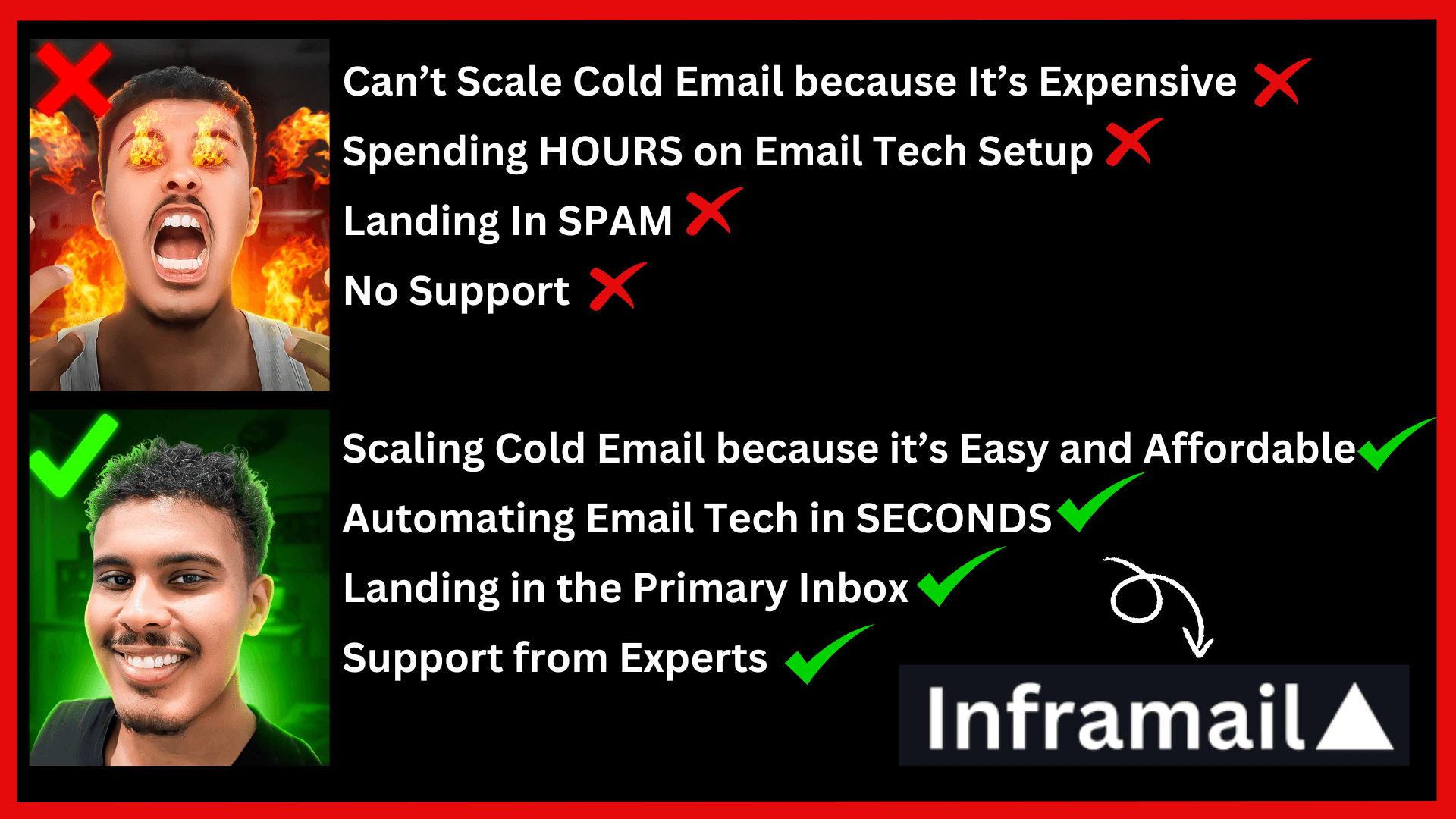
Related Reading
• Automated Lead Generation
• Email Prospecting
• How to Generate B2B Leads
• How to Warm Up Email Domain
• How Many Emails Can You Send Before Considered Spam
• Best Time to Send Cold Emails
• How to Cold Email
• Best Cold Email Templates B2B
• Email Outreach Best Practices
• Email Outreach Strategy
20+ Best Amazon SES Alternatives
1. Inframail
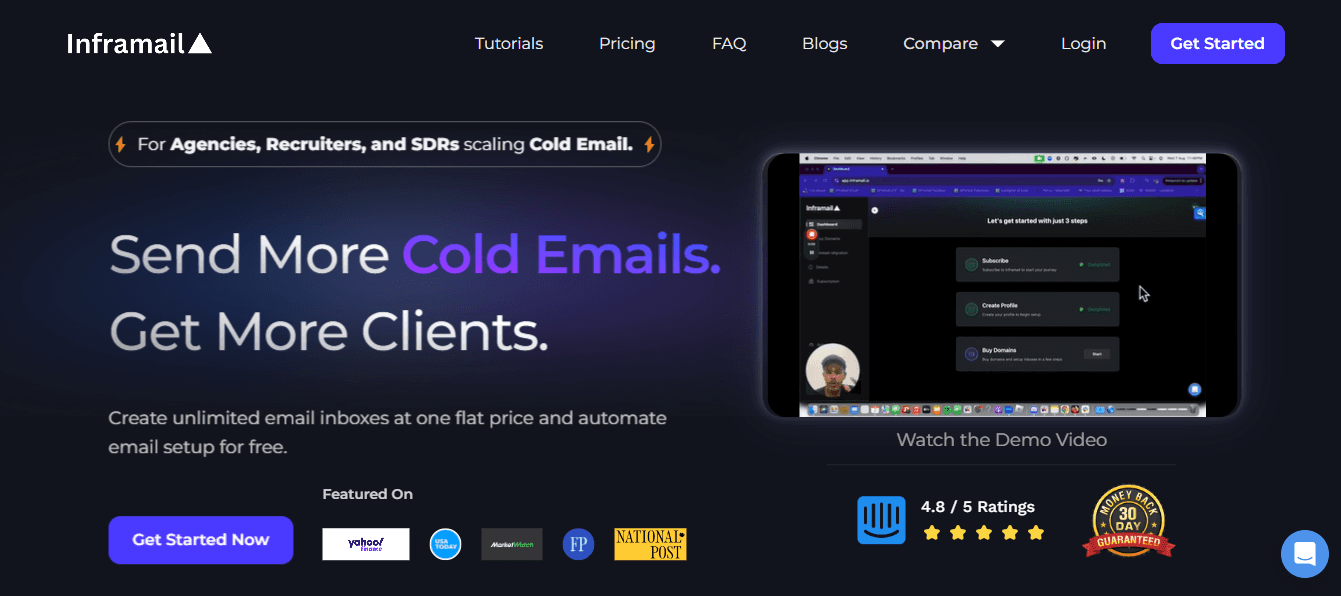
Inframail is changing the game for cold email infrastructure with unlimited inboxes at a single flat rate.
We provide:
Microsoft-backed deliverability
Dedicated IP addresses
Automated technical
It scales its cold email outreach efforts efficiently:
Agencies
Recruiters
SDRs
Main benefits of using our service:
Automated SPF, DKIM, and DMARC setup
Dedicated email servers for each user
16-hour priority support daily
Unlike traditional providers that charge per inbox and leave you wrestling with technical configurations, Inframail streamlines the entire process. We handle the complex infrastructure setup while you focus on reaching more prospects.
InfraMail provides the robust email infrastructure you need without the usual technical headaches and per-inbox costs, whether you're:
An agency looking to scale outreach
A recruiter connecting with candidates
An SDR driving sales
Start buying domains now and setup your email infrastructure today with our email infrastructure tool.
2. SMTP2GO

SMTP2GO is a bona fide cloud SMTP service provider. It specializes in bulk email sending with high deliverability rates. SMTP2GO works hard to protect sender reputation. It authenticates email addresses and checks blocklists to keep bounce rates low. It also helps you avoid sending to blacklisted or ‘spam trap’ email addresses. Doing either will quickly see you flagged as a ‘spammy’ sender.
After you hit Send, you get activity reports for every email. This helps you track deliverability and outcomes in fine detail.
Pros
Excellent deliverability
Automated spam detection and monitoring
Testing for 40 email clients
Event reporting for every email sent
Cons
No option to create emails or manage email campaigns.
SMTP2GO pricing starts at $15 a month for 40,000 emails.
There is a free plan with 1,000 emails per month.
3. Brevo
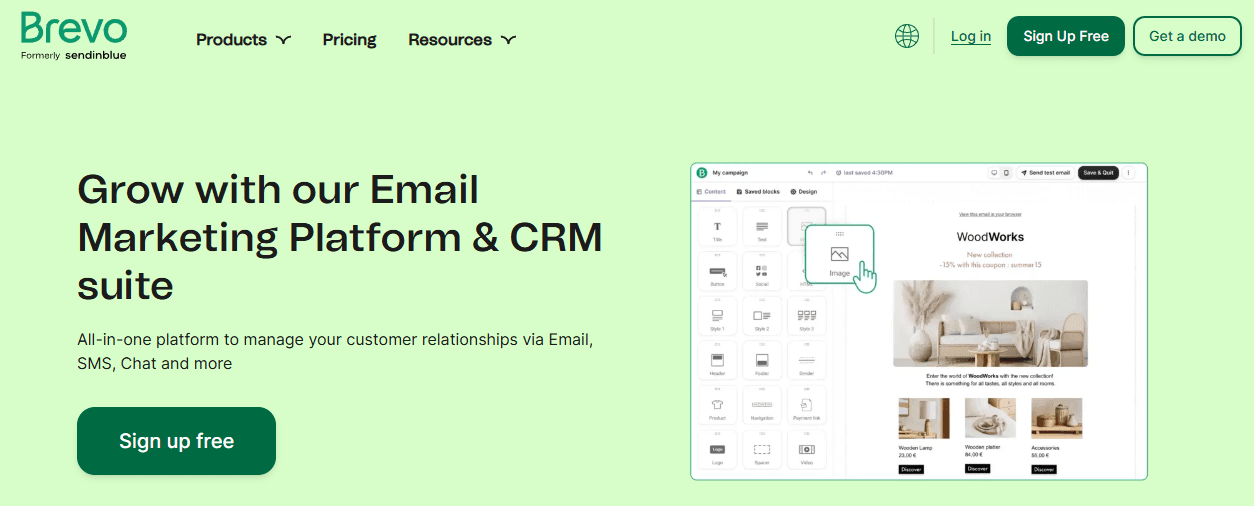
Brevo is an email marketing and CRM platform. But it includes an SMTP relay for transactional emails. This gives it one big advantage over Amazon SES. You can:
Write
Design
Send HTML emails
Using Brevo’s Automation Templates to Save Time
There are 40+ email templates to choose from. And a user-friendly drag-and-drop editor to customize designs. Another big plus of Brevo is that you can automate email sending. This is an option for both marketing campaigns and transactional emails. There’s a simple workflow editor to build automated sequences. And automation templates to speed up the process. Brevo walks you through the SMTP server configuration very clearly. You can also use an API to connect your website directly to the server.
Key Advantages of Brevo for Email Marketing
Pros
Design and send HTML emails from 1 tool
Full suite of email marketing tools
Automate sending of marketing and transactional emails
Send up to 300 emails a day for free
Cons
Higher per-email cost but worth it with all the tools you get.
Brevo pricing starts at $9 a month for 5k emails.
It has a free plan that lets you send 300 emails a day.
4. MailerSend
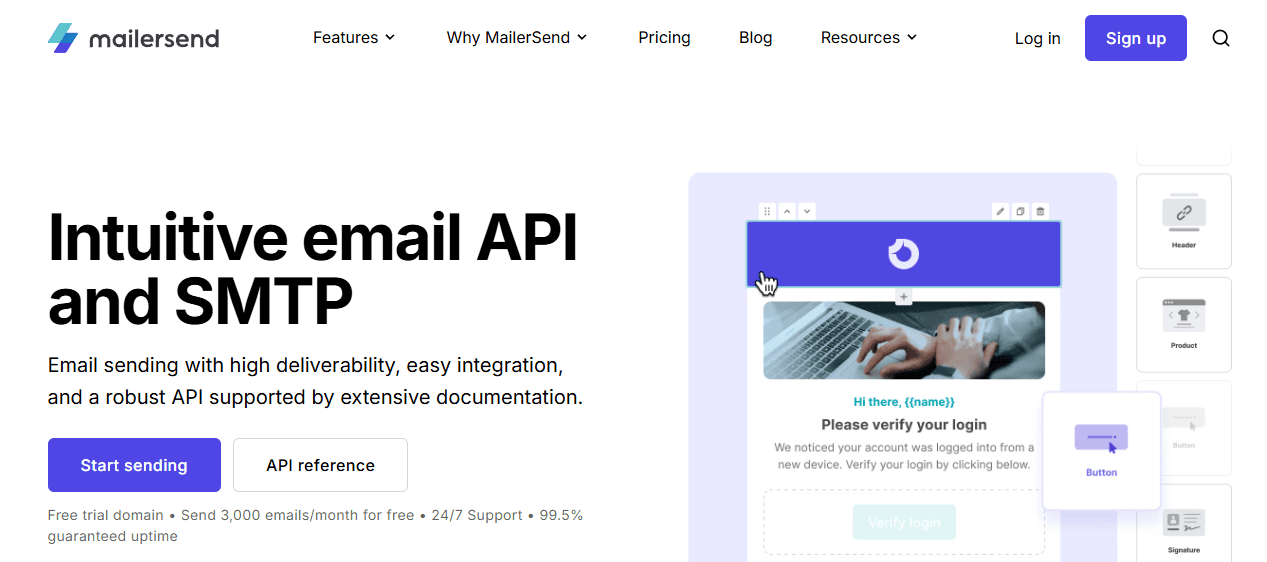
MailerSend is a transactional email service provider from the makers of Mailerlite. It specializes in:
Sending receipts
Password resets
Order and shipping confirmations
MailerSend supports bulk sending for businesses of all sizes. Its SMTP relay comes with a plug-and-play option for WordPress websites. This offers easier integration than using its API. For agencies, MailerSend lets you run multiple domains on the same account. You can choose a dedicated IP address for greater control.
How MailerSend's Email Verification Tool Protects Your Sender Reputation
A stand-out feature of MailerSend is that you can also design HTML emails within the platform. Email design is often overlooked for transactional emails. But MailerSend features a drag-and-drop email builder and editor. You can choose from pre-made templates to kick-start your designs. All templates support dynamic content so you can personalize every email. MailerSend has recently added an email verification tool. You can upload email lists as CSV files and MailerSend checks if they are in use and genuine. This avoids damaging your sender reputation by risking high bounce rates and looking for an email service provider for your small business? Read our full Mailerlite review to learn more about its features, costs, pros, and cons.
Is MailerSend Right for Your Business? Pros and Cons to Consider
Pros
Drag-and-drop editor for easy transactional email design
Dynamic templates for personalization
Bulk email list verification
Low-cost team accounts
Cons
No option to automate email sending.
MailerSend prices start at $24 a month for 50,000 emails.
This also includes 100 email verifications.
There is a free plan that lets you send 3,000 emails a month.
5. Moosend
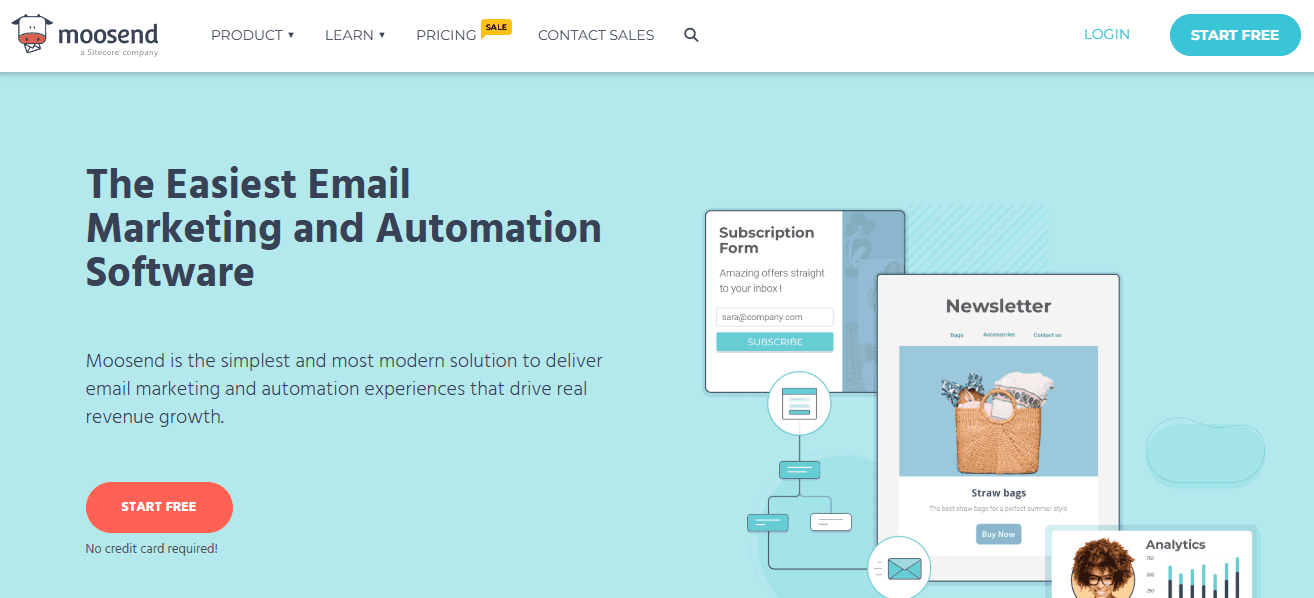
Moosend is best known as an email marketing service. It also offers a cloud-based SMTP service for high-volume sending. Moosend has a reputation for being a great value platform for small businesses.
Value Proposition: Balancing Cost and Features
There are two ways to compare it to Amazon SES cost-wise. All Moosend plans let you send unlimited emails. Starting at just $9 a month, Moosend wins hands down on per-email pricing. Moosend limits the number of contacts you can have, starting at 500. Amazon SES doesn’t. So you have to determine the best value for your business.
Automation Made Simple: Save Time with Moosend’s Workflow Tools
Highlighting Moosend’s automation capabilities for transactional and promotional emails:
Moosend lets you send promotional and transactional emails from the same place.
It’s easy to design quality HTML emails.
It has excellent automation options to save time.
E-commerce businesses can connect Moosend directly to their web store.
Site tracking lets you fire off automated, personalized emails based on what visitors do on your site.
There’s an AI tool that makes targeted product recommendations. You can also drop product listings straight into emails.
Moosend: A Cost-Effective Email Marketing Tool with a Few Caveats
Pros
Handles all your email needs from one platform
Low cost with no email sending limits
Easy email automation and personalization
Send promotional and transactional emails from your ecommerce store.
Cons
A free plan would be the icing on the cake.
Sign up to Moosend and get a 30-day free trial.
Pricing starts at $9/month for 500 contacts, unlimited emails, and all features included.
6. SMTP.com
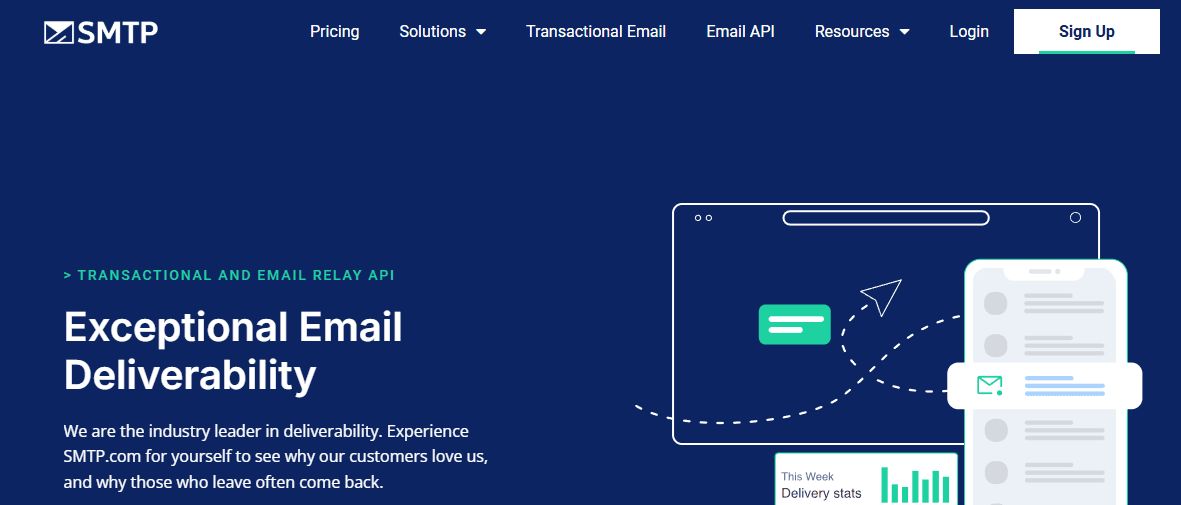
SMTP.com is a bulk email delivery platform that goes big on the bulk. Its custom service for high-volume senders starts at a minimum of 250 million monthly emails. It also has a flexible range of plans, building up from 50,000 emails a month.
Automation Made Simple: Save Time with Moosend’s Workflow Tools
Like most services on this list, SMTP.com combines a cloud SMTP relay with an API. For developers, it promises simple and fast integration. Migration templates make switching to SMTP.com from another relay or API easy. Another big thing in SMTP.com’s favour is its deliverability features. Its Reputation Defender is a powerful validation tool. It automatically scans for ‘bad’ emails in your list in real time. Or as SMTP.com puts it, “actively catches bounces before they happen.” It’s a clever tool, taking the weight of list hygiene and sender reputation off businesses. If you want all your sending needs taken care of, SMTP.com also offers a fully managed sending service.
High Entry Point: Evaluating SMTP.com's Pricing for Smaller Businesses
Pros
Designed for high-volume scalable sending
Automated list hygiene and sender reputation management
Exceptional deliverability rates
Easy API integration
Cons
As clever as the Reputation Defender tool is, it’s a paid-for add-on.
And SMTP.com’s plans aren’t the cheapest to begin with.
Essential plans start at $25 a month for 50,000 emails.
All plans from Starter up come with a dedicated IP.
There is no free plan or trial.
7. ActiveCampaign Postmark
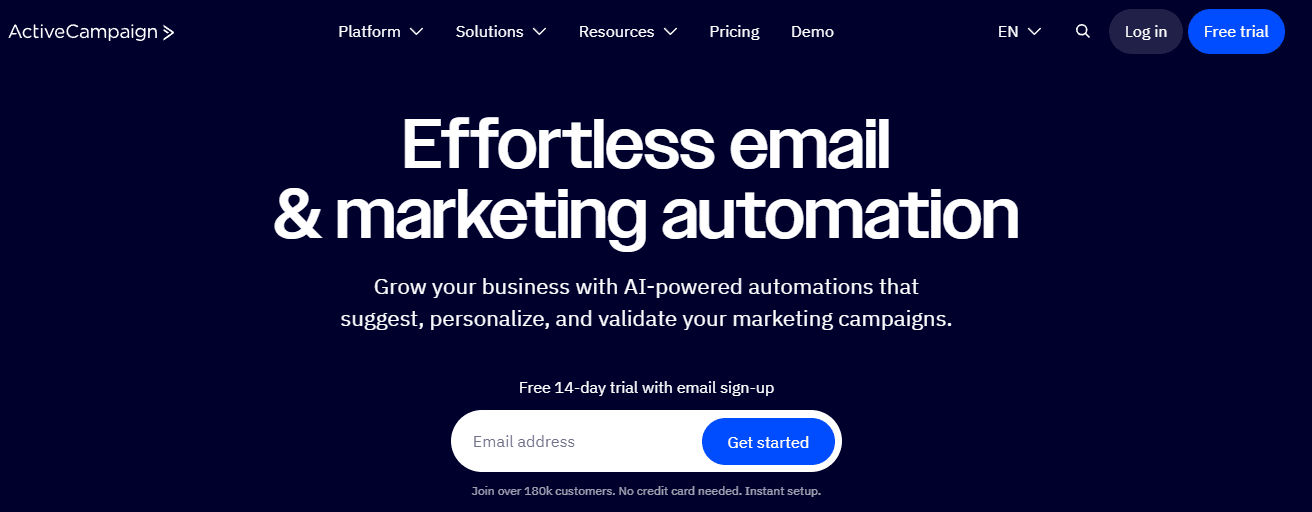
The transactional email service Postmark was bought by ActiveCampaign in 2022. ActiveCampaign is an email marketing and CRM platform. Postmark is the transactional email offer. When you add the transactional email ‘app’ in ActiveCampaign, you connect to Postmark. Becoming part of the ActiveCampaign family has expanded Postmark’s offer. To quote the site, “Postmark is no longer just for transactional email only.” It’s very much positioned for email marketing, too. You couldn’t send promotional emails through Postmark. And you can also use it as a mailbox for inbound emails.
The Postmark-ActiveCampaign Integration for Marketing Emails
ActiveCampaign postmark message streams. This has also led to a switch in Postmark’s email infrastructure. Postmark offers the usual SMTP relay and email API. But it has distinct ‘messaging streams’ for inbound, transactional and marketing email. You can create different streams for yourself. The idea is to protect sender's reputation across the different ways you use email. If marketing emails get flagged as spam, it won’t affect transactional emails. And vice versa. Postmark comes with templates for transactional emails. So, unlike Amazon SES, you don’t have to think about running another platform to create your own emails. If you want email marketing, there’s a direct connection to ActiveCampaign. Postmark also offers much better customer support than Amazon SES. The support team is available on phone and live chat.
How Postmark Stands Against Competitors
Pros
Protected ‘streams’ for sending marketing and transactional emails
Direct integration with ActiveCampaign for email marketing
Transactional email templates
Telephone and live chat support
Cons
Doesn’t have any list of cleaning tools
Postmark pricing starts at $15 a month for 10,000 emails
Dedicated IPs are available as a paid-for extra above 300,000 emails a month.
There’s a free trial that lets you send 100 emails.
8. Google
Google is not only the world’s biggest search engine. Gmail is also the world’s largest email client. It offers a full range of email services, including free personal webmail. And near-identical, though paid-for, business email. Gmail isn’t purpose-built for bulk email sending the way Amazon SES is. But you can still do it. It has its own SMTP relay and API. Or if you don’t fancy setting either of these up, you can just use Multi-Send Mode in your normal Gmail Compose screen.
Personal vs. Enterprise Gmail: Which Is Right for You?
Gmail automatically personalizes the greeting to every contact you send to. Both of these bulk-sending options are included with Google Workspace subscriptions. So for personal use, they are completely free. The catch? ‘Bulk’ in Gmail is not all that bulk. As an email client, Google is very cautious about its sender reputation. So, it imposes strict sending limits on public accounts. The trade-off is that Gmail’s deliverability is very high. Multi-sending is limited to 1,500 recipients per day. Which, over a month, works out as a generous sending limit. With the SMTP relay and API, you are restricted to just 100 recipients per message. And 10,000 recipients per day (so you could send 100 messages to 100 different people daily). These fall short of the open-ended sending limits of Amazon SES. You can scrap these limitations with a Gmail Enterprise account if you need to. This gives you a unique domain so you’re in charge of your sender reputation.
Google as an Email Marketing Tool: A Double-Edged Sword
Pros
Free with Google Workspace accounts
Multiple bulk sending options available for Gmail users
High deliverability
Automatic personalization
Cons
Low send limits
9. Mailgun

Mailgun is a transactional email service for developers. Like Amazon SES, it combines an SMTP relay service with an email API. This means you can plug email-sending into any platform you like. Mailgun doesn’t try to compete with Amazon SES on price. It works out as a minimum of 7 times more expensive for every email you send. Instead, Mailgun focuses on delivering a much more complete all-round service.
Sender Reputation Management: How Mailgun and Amazon SES Stack Up
Amazon SES is pretty easy to integrate with websites on AWS (Amazon Web Services). But Mailgun makes a point of making its API hassle-free to connect to any platform. It offers multiple REST APIs for different environments, frameworks and programming languages. And detailed, user-friendly documentation for each. Plus, it offers 24/7 support. You’re more or less left on your own with a service the size of Amazon SES. Mailgun matches Amazon SES on:
Sender reputation management
Deliverability
Testing tools
Why Email Verification Is Crucial for Your Email Marketing Strategy
Where it goes one better is with send time optimization and email verification. If you’re looking for a standalone tool for email validation, check out our review of the best email verification tools. An AI tool also identifies when contacts are ‘in’ their inbox, automatically sending emails at that time. You can check your email list to sift out defunct or fake addresses. Mailgun also scores a win with how it handles multiple domains. If you are an agency setting up separate domains for your clients, they are treated as separate. A dip in sender reputation on one will not affect deliverability in another. Amazon SES lumps multiple domains on the same account together.
The Pros and Cons of Mailgun Pricing: What You Get for Your Money
Pros
Great option for agencies running multiple email domains for clients
High levels of support for developers
Email verification
Cons
On the expensive side, especially for small businesses
Mailgun pricing starts at $35 a month for 50,000 emails
A dedicated IP costs an extra $50 a month
There’s no free plan, but you do get a one-month free trial with a 5,000-email limit.
10. SendGrid
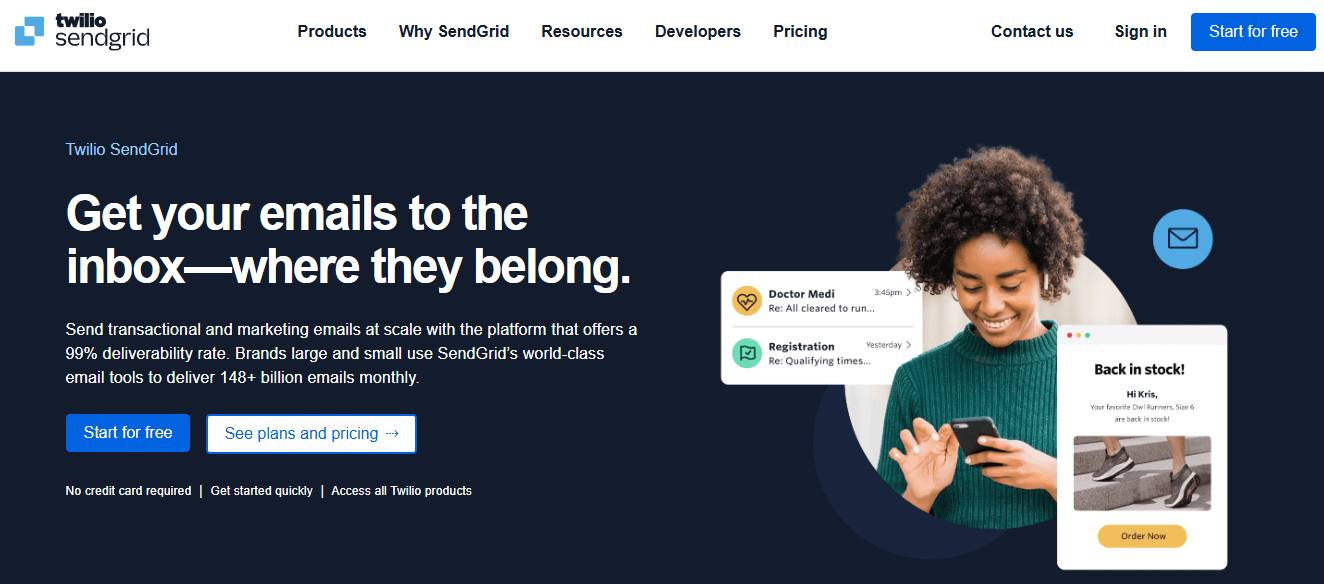
SendGrid is a business email service with a:
Cloud SMTP relay
Email API
Email marketing tools
Scaling Your Email Campaigns with SendGrid’s Volume Management Tools
You can run promotional email campaigns and transactional emails in one place. And high sending volumes aren’t an issue. Deliverability is a big strength of SendGrid. It claims to send over 100 billion emails every month. All new accounts go through a process called IP warmup. This limits and then gradually increases send volumes according to a fixed schedule. This gives ISPs and email clients time to ‘get used’ to your IP sending large volumes and not flag you as spam right away.
The Role of IP and Domain Authentication in SendGrid’s Deliverability
SendGrid analytics geographic data. Beyond that, your IP address configuration is optimized according to monthly send volumes. SendGrid authenticates domains and IP addresses using:
SPF
DKIM
Reverse DNS
It provides in-depth reporting to help maintain a positive sender reputation. This includes blacklist monitoring. You can also validate emails before you hit send to lower bounce rates.
Looking Beyond SendGrid for Advanced Email Marketing Tools
SendGrid is a better bulk email-sending platform than an email marketing tool. It does a decent job of running email campaigns. There are responsive templates to choose from. And a simple-to-use editor. You can set up simple automations to save time. But SendGrid’s email marketing tools don’t have the range and sophistication of, say, Brevo or Moosend. If you’re looking for an alternative with better email marketing features, check out the best SendGrid alternatives here.
The Pros and Cons of Using SendGrid for Both Transactional and Marketing Emails
Pros
Excellent deliverability
Offers transactional emails and email marketing in a single platform
Email validation API
In-depth email analytics
Cons
Sendgrid’s email marketing options are useful but a little basic
SendGrid pricing starts at $19.95 a month for up to 50,000 emails.
Pro plans come with a dedicated IP included.
There is a free forever plan with 100 emails per day.
11. Elastic Email
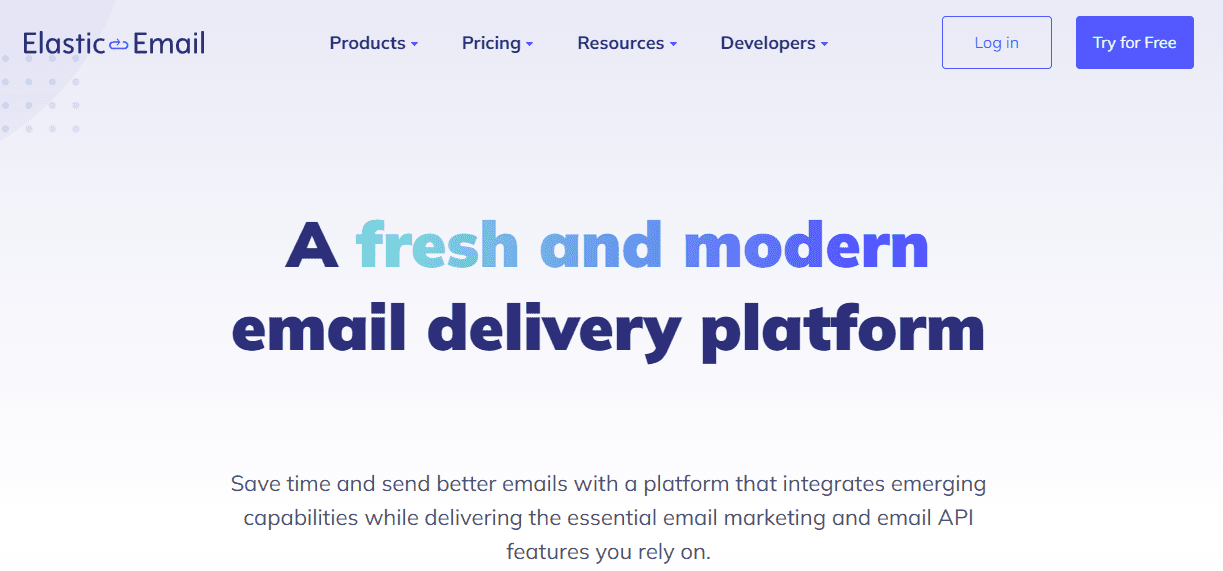
Elastic Email is an email marketing and delivery service offered as separate services. The bulk-sending option is an API.
Maximizing Email Engagement with Elastic Email’s Reporting Tools
Key features:
It includes a range of deliverability features, including email verification.
You also get standard SPF and DKIM validation.
You also get extra deliverability features like IP warm-up if you purchase a private domain.
Backing up these deliverability tools, Elastic Email offers in-depth analytics.
Reporting covers the usual status checks like:
Delivered
Opened
Clicked
Unsubscribed
You also get insights about why contacts unsubscribe.
Maximizing Email Automation: How Send Time Optimization Boosts Engagement
For email marketing:
A drag-and-drop email builder with pre-made templates.
Campaign automation, including send time optimization.
Landing pages and forms.
Personalization, contact segmentation and dynamic content.
The only shame is that these aren’t available as a single bundle. You have to pay for the email marketing tools and transactional emails separately. But you get the email builder and templates with an Email API account. So you can build good-looking transactional emails that fit with your brand identity.
Elastic Email: A Versatile Email Solution with Some Limitations
Pros
Advanced features for reliable email delivery
In-depth analytics
Drag-and-drop builder for transactional emails
Email marketing tools
Cons
SMTP relay API and email marketing are available as separate plans only.
The Elastic Email API plan starts at $9 a month
For 10,000 emails
The email marketing plan also starts at $9.
You can send up to 60,000 emails a month to 2000 contacts.
Both have a free version limited to 100 emails a month. If you send 100M+ emails per month, you can get a custom plan.
12. Mailchimp Transactional

Mailchimp Transactional might be a good SES alternative for your transactional emails if you are either:
An existing Mailchimp customer
Planning on becoming one
That’s because Mandrill used to be a standalone service, but it now only exists as a paid add-on for existing Mailchimp users.
Mailchimp and Mandrill: A Powerful Duo with Some Drawbacks
Pros
One-stop shop: The Mailchimp plus Mandrill combo gives you a well-integrated package if you need it all
Email
Marketing
Automations
Strong analytics: Mailchimp offers robust analytics that include:
Customizable options
Pre-built dashboards
An export API
Cons
Lack of product focus: Mailchimp’s main focus is likely on email marketing automation. Being an add-on, Mandrill might not be getting the same amount of love.
Cost: Both Mailchimp and Mandrill are expensive (especially compared to Amazon SES). And yes, you’ll have to pay for both.
Mandrill's Pricing: A Trade-off Between Flexibility and Cost
Pricing
Bulk emails are sold in blocks of 25k emails, and the cost per block varies depending on the total monthly email volume you want to buy. This cost is in addition to a Mailchimp monthly plan, so make sure to combine the two for the most accurate picture of your email-sending costs:
Send 10,000 emails?
$20 (+the price of your regular Mailchimp subscription)
Send 300,000 emails?
$240 (+the price of your regular Mailchimp subscription);
Send 1 million emails?
$720 (+the price of your regular Mailchimp subscription).
13. MessageBird Email (formerly SparkPost)
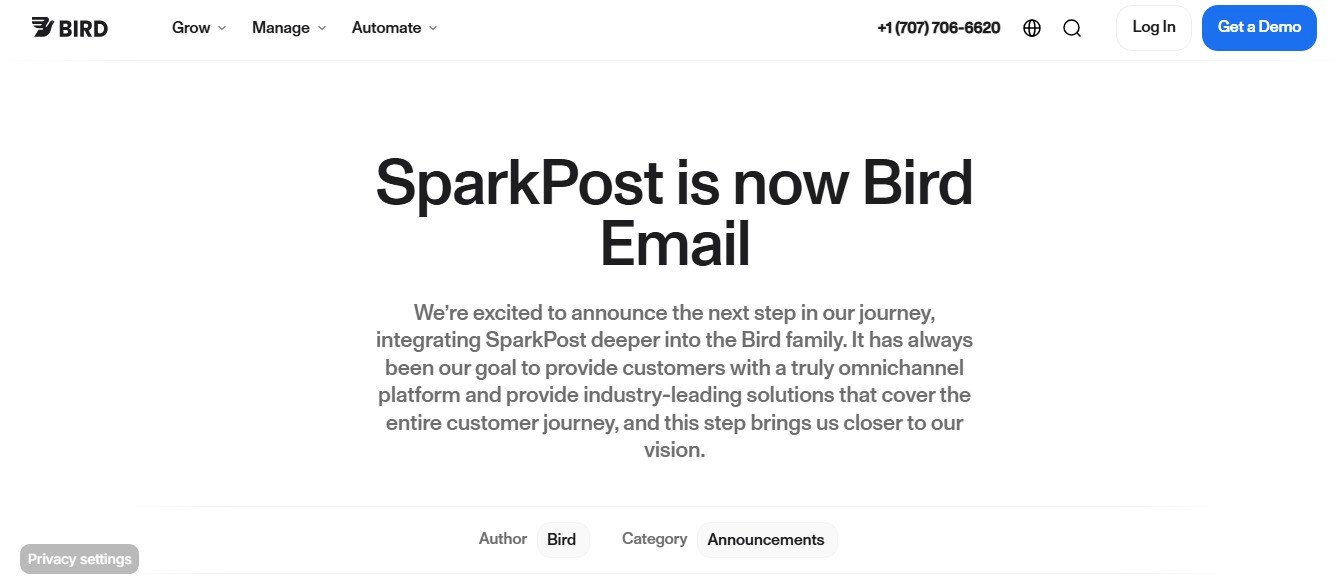
The brand formerly known as SparkPost, MessageBird Email, claims to deliver 40% of all commercial emails worldwide, with over 4.5 trillion annual sends. This number is far too large for us to comprehend or compare ourselves to, so we’ll just say it: it sounds like an impressive amount of emails!
MessageBird goes well beyond email delivery, with:
Enterprise-level analytics
Competitive intelligence features
A focus on high-volume commercial sending
In that sense, it’s similar to SendGrid, which we covered above. If you run an enterprise business and/or work in a highly regulated industry, it’s likely to be a solid partner for your needs.
MessageBird: A Reliable and Feature-Rich Communication Platform
Pros
99.99% uptime guaranteed by SLA.
Detailed developer docs: the comprehensive documentation help users and customers navigate MessageBird’s complex features.
Compliance and enterprise support: Businesses in industries with specific security and compliance regulations (e.g., finance, or health) will find what they need in MessageBird, but what’s a pro for one company may be a con for another.
Evaluating MessageBird's Pricing for Different Email Volumes
Pricing
MessageBird offers three service levels (Starter, Premier, and customized Enterprise plans) with different features, each covering different email volume levels. Here’s what MessageBird will charge for sending your emails:
What does it cost to send 10,000 emails?
$20/month (Starter);
What does it cost to send 300,000 emails?
$205/month (Premier plan + overage fees);
What does it cost to send 1M emails?
$525/month (Premier).
14. UniOne
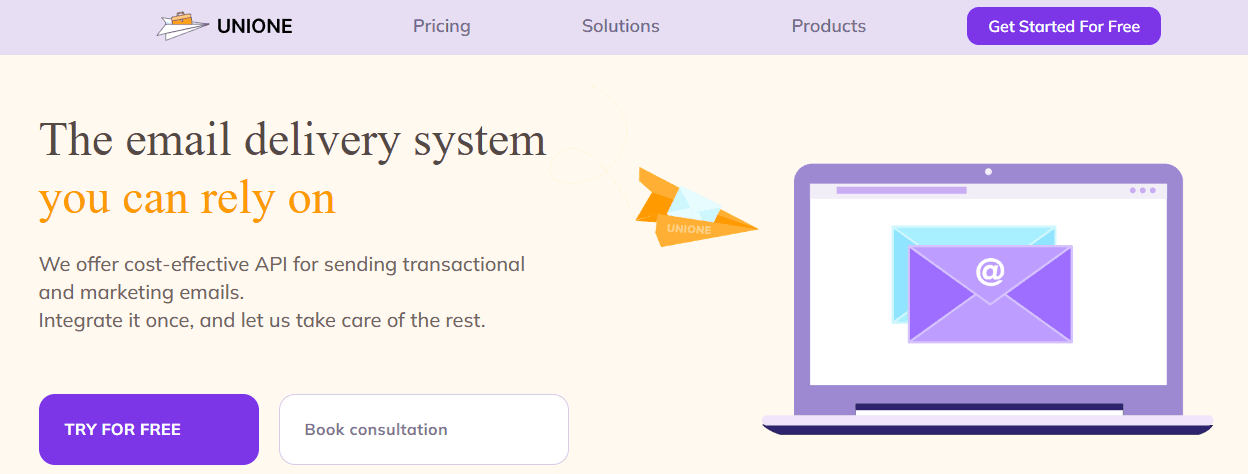
UniOne is one of the most optimal Amazon SES alternatives for businesses. It offers the perfect blend of:
Affordability
Security
Reliability
Speed for your customer emails
UniOne: A Reliable Solution for Automated Email Delivery
UniOne lets you send automated transactional or marketing emails without stress. You just need to integrate your website or app once using Web API or SMTP connection. The service boasts a 99.8% deliverability rate and stellar email delivery speed. A dedicated IP address may be purchased separately if you need one for your brand. The support team is available 24/7 to lend a helping hand to your email needs.
UniOne: A User-Friendly Platform with Robust Technical Support
UniOne offers a clear, intuitive dashboard that any non-specialist can navigate. You can:
Quickly sift through different features
Checking your email statistics
Delivery rates
Click-throughs
More in real-time
The platform has detailed technical documentation to help you understand every aspect of using it to send emails.
UniOne's Competitive Pricing: A Value Proposition for Businesses
Prices start from $6 monthly for 10,000 emails, and you can pay an extra 0.75 for every additional 1,000 emails. With UniOne, you can pay $850 monthly for 3 million emails, which is quite a bargain. A dedicated IP address costs $20 for the initial setup plus a recurring $40 monthly fee. Most other Amazon SES alternatives charge above $50 monthly for the same service.
15. Bird (formerly SparkPost)
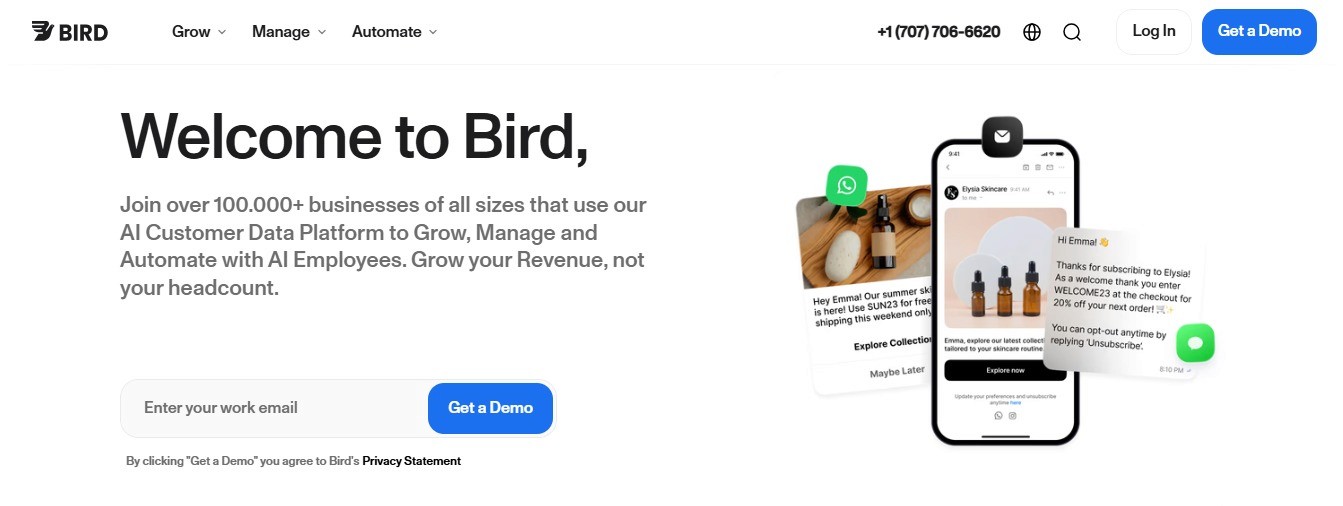
Bird is another Amazon SES alternative for sending emails to global customers. It provides APIs that let brands reliably send voluminous emails. This platform claims its infrastructure handles up to 500 million messages per hour with less than 2 seconds of delivery time.
Bird: A Powerful Tool for Efficient Email Marketing
Users can access detailed analytics on their customer emails, helping them know when to adjust to improve customer experience. Your Bird dashboard shows 42 real-time metrics about your emails. You can set up Bird and send emails within 10 minutes– that’s how easy the interface is to navigate.
Bird's Pricing: Balancing Flexibility and Cost
Bird's monthly pricing starts from $45 for 3,000 contacts and 30,000 emails. The final price depends on your mailing list’s size and email frequency. Of course, you can contact Bird’s sales team to negotiate a custom plan with unlimited contacts and emails.
16. ZeptoMail
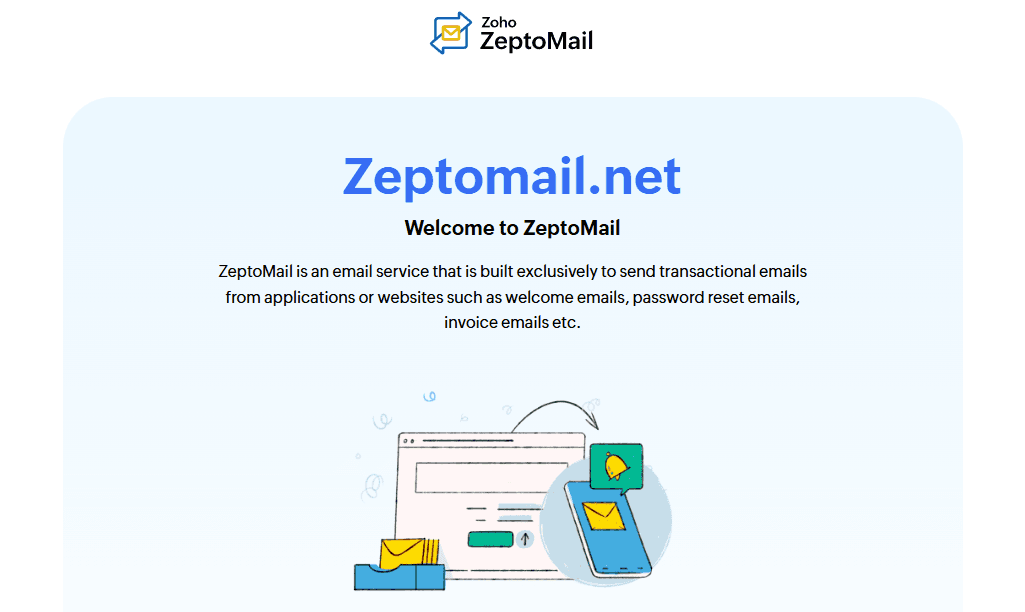
The transactional email service from Zoho, ZeptoMail specializes in fast delivery and inbox placement for application emails. It efficiently communicates important transactional-related information to customers.
ZeptoMail's Unique Features for Optimized Email Delivery
ZeptoMail offers a range of unique features and services that enhance its value as an Amazon SES alternative. One notable feature is:
Its ability to create and boost email reputation, ensuring your emails have a higher chance of reaching the recipients' inboxes.
With email tracking, ZeptoMail provides valuable insights into email performance, enabling you to monitor bounce, open, and click rates effectively.
The ZeptoMail API integration further facilitates tracking and monitoring, empowering you to optimize your email campaigns and deliver outstanding results.
ZeptoMail: A Specialized Solution for Transactional Email
Pros
Maintains a strong sender reputation
Offers separate email streams, email templates, and email tracking
Provides WordPress plugin and file cache
Offers email templates for common types of transactional emails.
Cons
Focuses solely on secure and dedicated transactional email services
Challenges reported in importing data from different apps
Lack of essential features such as scheduled delivery and rules engine
Doesn't support bulk email sending.
Despite not offering some key marketing tools, ZeptoMail excels in its core offering, ensuring high deliverability and keeping a positive reputation among senders.
17. Mailjet
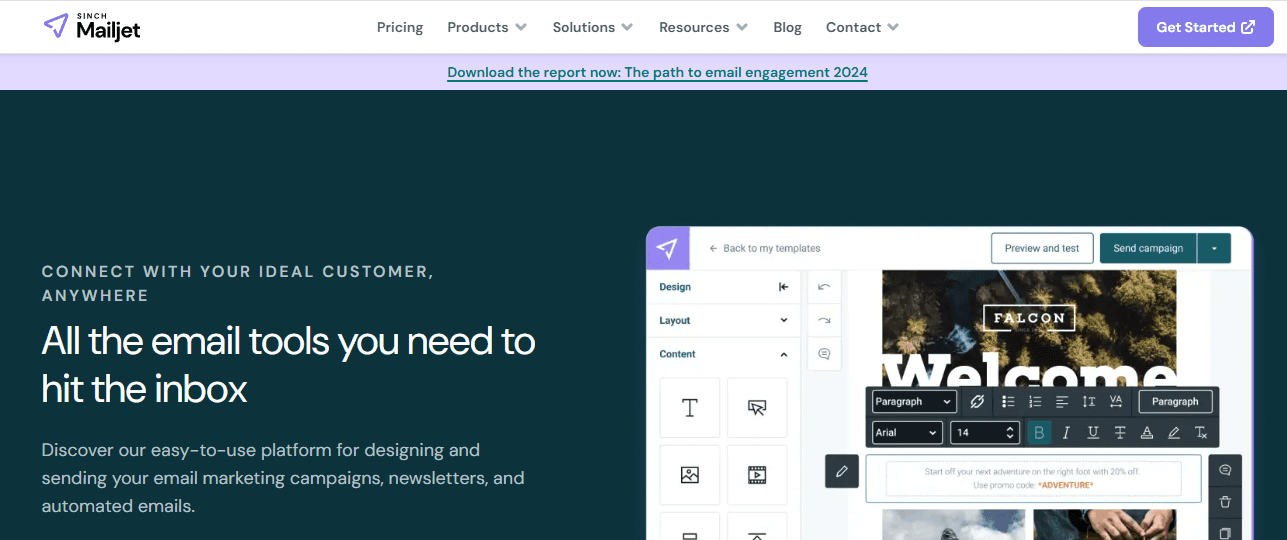
Mailjet is concerned with both marketing and transactional emails, with an emphasis on collaboration. It includes a real-time collaborative email editor that belongs to team members' email drafts and aggregates their inputs. In addition, the Mailjet API support, which is enriched with advanced segmentation and personalization features, is also one of its best features.
Mailjet: A Versatile Email Marketing Tool with Areas for Growth
By factoring in pricing plans that apply to SMEs and large-scale organizations, it will be in a position to serve the needs of all. Mailjet’s strongest point is the interactive interface and inter-working tools available. Yet, to some extent, there is a gap between its analytics and reporting functions compared to other providers.
Mailjet: A Feature-Rich Email Marketing Solution with Competitive Pricing
Top Features:
Email API
SMTP Relay
Marketing Automation
Real-time Analytics
A/B Testing
Drag-and-Drop Email Editor
Contact Segmentation
Pricing
Free:
$0
Essential:
Starts from $15/month
Premium:
Starts from $25/month
Custom:
Custom
18. SendPulse

SendPulse is a multi-channel marketing platform that specializes in email service alongside other communication channels like:
SMS
Web push notifications
Chatbot
SendPulse: A Versatile Email Marketing Platform for Enhanced Customer Engagement
Its versatility makes it an attractive alternative for businesses looking to centralize their communication efforts. For email services, SendPulse provides a user-friendly platform with a robust set of features. Its drag-and-drop editor, numerous templates, and image library make email creation straightforward.
Advanced features like:
Segmentation
Personalization
A/B testing
Detailed analytics
It helps tailor your emails for the best results. One of SendPulse unique features is its AI platform, which predicts the best time to send emails to your subscribers, thus maximizing open rates. Combined with automated email sequences, this can significantly boost your email marketing effectiveness.
19. OneSignal Email

OneSignal Email offers a unique blend of email marketing and push notifications. It is a great choice for businesses looking for a multi-channel communication platform to engage their users. OneSignal Email provides a user-friendly platform for crafting emails. It makes email creation a breeze because of this elements:
Drag-and-drop editor
Pre-designed templates
Rich media support
OneSignal: A Comprehensive Platform for Email and Push Notification Marketing
Enabling you to tailor your emails to your audience, this platform supports:
Segmentation
Personalization
Automated email sequences
OneSignal stands out with its push notification features. You can easily convert email subscribers to push notification subscribers and vice versa. This multi-channel approach ensures you can reach your audience in the most effective way possible. OneSignal provides real-time analytics to track and optimize your email and push notification campaigns.
20. ReachMail
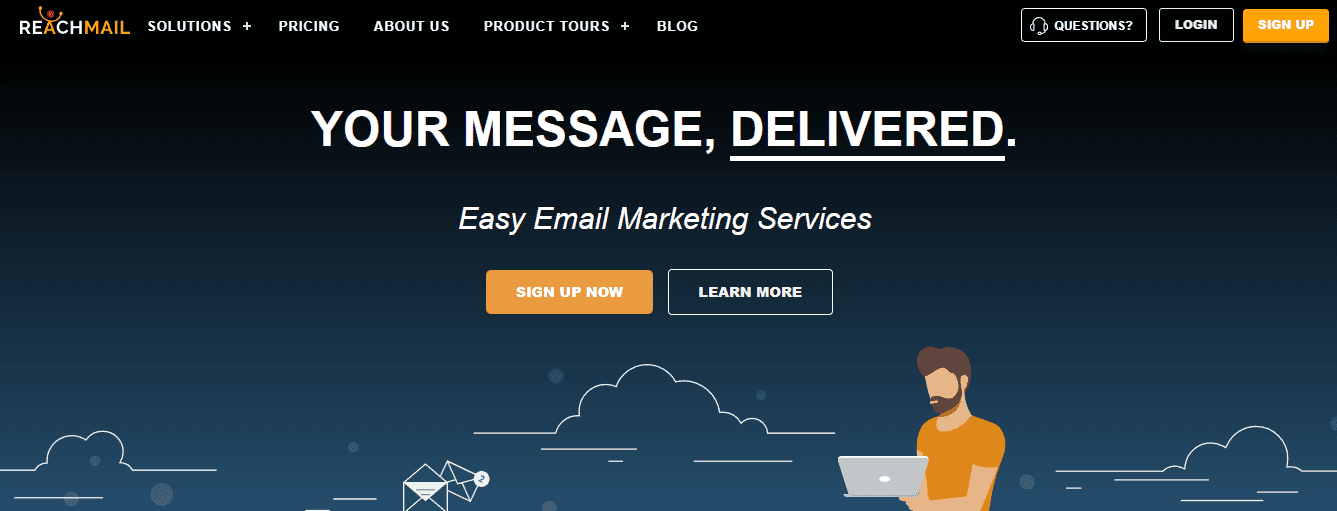
ReachMail is a versatile email marketing solution catering to businesses of all sizes. It is designed to help companies to mass email marketing campaigns, all while tracking the results in real time:
Create
Schedule
Send
ReachMail: A Comprehensive Email Marketing Solution for Businesses of All Sizes
ReachMail key selling point is its intuitive interface and robust feature set, which includes a:
Drag-and-drop editor
Pre-designed templates
Advanced list management and more
The service supports A/B testing and provides detailed analytics to help improve the effectiveness of your campaigns. ReachMail provides excellent deliverability rates, thanks to its adherence to best industry practices and strong relationships with ISPs. With 24/7 customer support and powerful features, ReachMail is a reliable and user-friendly email service.
21. Netcore Email API (formerly Pepipost)
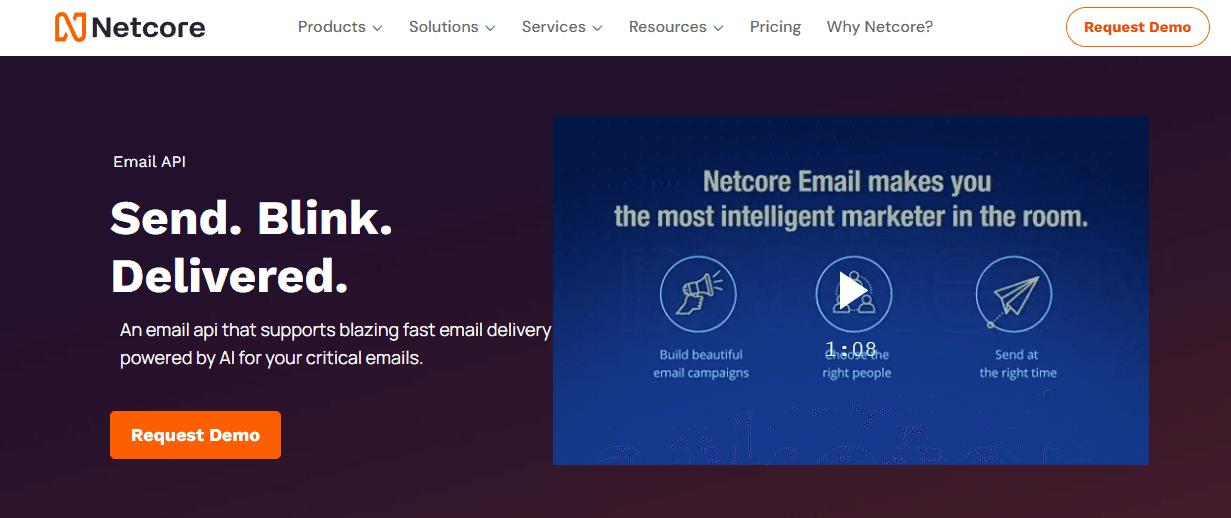
Netcore Email API, previously known as Pepipost, is a renowned platform for sending transactional emails in real-time. It caters to:
Startups
SMEs
Large enterprises
It provides reliable email delivery with a clean and user-friendly interface.
Netcore Email API: A Powerful Tool for Efficient Email Delivery
Netcore Email API excels with its features including:
Real-time reports
Webhooks for event tracking
Sub-user management
It also supports SMTP and API integration, providing flexibility depending on your business needs.
Netcore Email API: A Comprehensive Solution for Reliable Email Delivery
What sets Netcore Email API apart is its ‘Email Health Report‘which presents insights into email performance and spam issues. It also offers 24/7 chat support, making it easy for users to resolve problems promptly. As an added advantage, Netcore Email API provides AI-powered email delivery, utilizing machine learning algorithms to improve email open rates. These features and competitive pricing make Netcore Email API an excellent choice as an alternative to Amazon SES.
Related Reading
• Best Cold Email Software
• How Long Should a Cold Email Be
• B2B Cold Email Response Rates
• How to Improve Email Deliverability
• Unlimited Email Hosting
• Email Testing Tools
• Best Email Deliverability Tools
• Email Scraping Tools
• Best Sales Prospecting Tools
• Email Warm Up Tools
• Email Personalization Tools
• Sales Email Automation Tools
• Mailscale Alternatives
• Mailforge Alternatives
6 Factors for Choosing a Suitable Amazon Ses Alternative

1. Key Features of Your Amazon SES Alternative
Before selecting an alternative to Amazon SES, assess its feature set. What tools does it have for sending bulk cold emails? For instance, to send automated emails, look for a platform that supports templates to make the process easier. A/B testing tools can also be useful for optimizing your cold email campaigns. Check the platform’s sending limits. If you want to send large emails, you’ll need to ensure the service can accommodate your goals. Look at the platform’s IP address offerings. A dedicated IP address can help improve your sending reputation, so check if this is available.
2. Unpacking the Reliability of Your Email Service
You need a cold email service that you can rely on. Your email service guarantees speedy delivery and has a great:
Uptime
Excellent deliverability rates
Robust infrastructure.
Avoiding Email Delivery Pitfalls: Choosing the Right Amazon SES Alternative
An unreliable email service can cause many problems. Customers might not see their emails delivered and end up needing clarification. Emails could arrive slowly, frustrating your addressees. There’s no trade-off for reliability when choosing an Amazon SES alternative. You can check existing reviews to evaluate the reliability of an email service. If many customers complain about the platform’s dependability, it’s a signal to look at other alternatives.
3. Pricing for Your Email Tool
Pricing is critical when choosing an Amazon SES alternative. You should choose something you can afford in the long term to avoid problems. Most email service providers showcase prices on their website, so it shouldn’t be difficult to estimate what you’ll pay based on your usage. The final cost usually depends on your chosen features and email volume. Consider your usage level and calculate what you can afford to pay for an email service. Look at platforms that fit within your budget to avoid any future issues.
4. Scalability and Growth of Your Email Service
Every business strives for growth, and your email service should be able to accommodate this need. It should handle increasing email volumes without sacrificing quality and performance. If you’re a high-growth company, look for an email service that simplifies your plan and increases sending limits. It should have a robust infrastructure to handle your growing demands. A scalable Amazon SES alternative should keep customers happy as their email list grows.
5. User-Friendliness of Your Email Service
An ideal email service should have an intuitive interface that is easy to navigate. Sending emails to customers is already tricky enough. You don’t need an email service that complicates things further with its interface. The interface should be responsive and intuitive, with features neatly arranged across the dashboard. You should be able to find relevant features anytime, and getting familiar with the platform's interface shouldn’t take too much time and effort.
6. Third-Party Integrations for Your Email Tool
Your email service should have third-party integrations to provide extra functionality. For example, you could connect it to your e-commerce software to send automated messages based on customer actions or to an external CRM to manage customer relationships via email. Any worthwhile Amazon SES alternative should have an extensive library of third-party integrations for users.

Start Buying Domains Now and Setup Your Email Infrastructure Today
At Inframail, we are revolutionizing cold email infrastructure with unlimited inboxes at a single flat rate.
We provide:
Microsoft-backed deliverability
Dedicated IP addresses
Automated technical setup
It scales its cold email outreach efforts efficiently:
Agencies
Recruiters
SDRs
Main benefits of using our service:
Automated SPF, DKIM, and DMARC setup
Dedicated email servers for each user
16-hour priority support daily
Unlike traditional providers that charge per inbox and leave you wrestling with technical configurations, Inframail streamlines the entire process. We handle the complex infrastructure setup while you focus on reaching more prospects.
InfraMail provides the robust email infrastructure you need without the usual technical headaches and per-inbox costs, whether you're:
An agency looking to scale outreach
A recruiter connecting with candidates
An SDR driving sales
Start buying domains now and set up your email infrastructure today with our email infrastructure tool.
Related Reading
• Maildoso Alternatives
• Mailgun Alternatives
• Sendgrid Alternatives
• Mailreef
• Cold Email Marketing Services
• Cold Email Services
• Lemlist vs Instantly
• Smartlead vs Instantly


